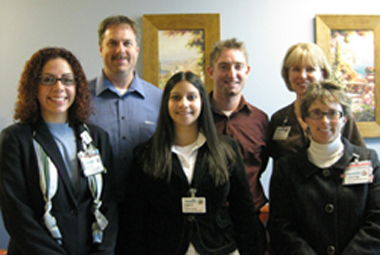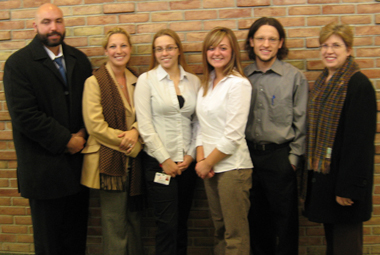 |
The Radiology Team:
(front row) Megan Johns, Pamela Najjar, Christine McGee
(back row) Robert Boylan, Robert Tibedeau, Sharon DeMeyere
|
 |
The OR Team:
(left to right) Gary Altman, Gretchen Pagac, Adrea Toth
Donnelly, Michelle Dick, Jon Polom, Gail Pietrzykfront
|
Industrial and systems engineering majors at Oakland University are now using student internships at Crittenton Hospital Medical Center in Rochester to complete their senior design projects.
OU was the first college to partner with Crittenton when they started the internship program in the summer of 2006.
The program started when Crittenton Hospital contacted OU to see if it had industrial and systems engineers to help out with process improvement at the hospital.
Bob Van Til and Sankar Sengupta, industrial and systems engineering professors and working team members of the Oakland University Pawley Lean Institute, worked with Crittenton personnel to develop the internship program.
The Pawley Lean Institute is designed to benefit university students, local schools, businesses, non-profits and industry by sharing the concepts and practices of Lean learning via OU courses, student labs and projects, and training workshops.
“Our staff loves having interns in their department because they’re there to help,” said Gary Altman, program leader of process engineering at Crittenton Hospital.
Crittenton has a Process Engineering Steering Team that meets every month to look over proposed projects.
“They all have an impact on business metrics for the hospital,” Altman said. The hospital has more work than help right now so not every project can be worked on.
All of the interns are industrial and systems engineering majors who are using this experience for their senior design projects.
Jon Polom, Michelle Dick and Adrea Toth are working on a project in the operating rooms while Pamela Najjar, Robert Tibedeau and Robert Boylan are conducting their project for the Radiology Department. Typically, all OU engineering majors work on a joint senior design project that focuses on design of a product rather than a system.
According to Tibedeau, it’s important for industrial and systems engineering majors to do this type of senior design project, one that’s related to their career choice.
Najjar agreed. “I think it’s more effective for the ISEs to work together on a project like this.”
The goals for the OR project are to keep traffic and infection rates down, improve patient safety and increase efficiency. According to Dick, the interns found from their research that if traffic is reduced, it does help the safety of the patient. To achieve their goals, the interns observed how many people come in and out of the OR.
“I like sitting in the OR,” Dick said. “It’s just different being in there.”
Polom, the third intern hired into the program who has worked there for several semesters, said that the interns use the scientific method to implement their process improvements. According to Dick, the interns take all tools they learned in class and use them to perform the project, such as charts and data analysis.
“It’s helping me a lot to see what areas people are trying to change and how to go about that,” Dick said.
The Radiology Throughput Project aims to improve the Out-Patient Imaging Center. The goals of this project are to improve the start to finish process, minimize patient and staff wait time, increase efficiency and decrease workload.
The interns are focusing on walk-ins, x-rays, ultrasounds, mammograms and bone density tests. They took measurements of the work area in order to find a way to minimize steps and save time.
“The Crittenton Imaging Center is not at maximum capacity, and we’re trying to get them there,” Najjar said.
Najjar said that prior to the internship she didn’t know the process of radiology and didn’t realize what was holding up patients. Now she has received data and seen how it affects people firsthand.
“Mostly, I learned how to apply,” Najjar said. “And that’s exactly what I’ve been looking for.”
The projects are big on leadership skills. Polom said he learned how to effectively manage projects.
“The only way you’ll ever really get it down is by doing it,” he said. Polom also said he learned that the most important thing is the ability to handle people, and industrial engineering is a very people-oriented field.
“As an industrial engineer, it’s useful actually doing something that’s related to your career,” Polom said. “It’s good to have that experience.”
According to Tibedeau, he learned about data collection, process mapping, and the different ways people do the process and the way it should be done. “I think that actual real world experience is my favorite part,” he said.
Najjar said she is taking away real life application skills from the experience. “You don’t really get to experience that. It’s once in my college career,” she said.
Lean principles are an important part of the internships. At first, Altman finds out if the interns are trained in or know about Lean and Six Sigma, which is what Crittenton’s Process Engineering Department is based on. If not, he has them read a book about it.
“We use quite a bit of Lean in the stuff here,” Polom said. “In general, it just means cut down the waste. That’s definitely what I do.”
According to Altman, the interns start with value stream mapping. Tibedeau said they use Lean principles by cutting down on non-value added time.
“Industrial engineering has been doing Lean forever, cutting down on waste,” Polom said. “Industrial engineers are all about efficiency.”
Dick presented an example of using Lean if the supply location in the OR turns out to be the problem. “We can look at Lean principles to see where the best spot to put the supplies will be,” she said.
The interns meet biweekly with the Crittenton staff and Altman on opposing weeks. They are able to do work on their own time, generally two or three times a week.
Altman, with the help of Van Til and Sengupta, supervises the interns, facilitates project teams, overviews projects and helps with data analysis. His job is to grow the internship program, which he said he’s happy with.
The summer internship is for 40 hours a week, where students work on one project with a bigger scope and are paid. The winter and fall internships are for 20 hours a week. The senior design projects are unpaid, but the students are receiving course credit.
“I would definitely recommend it to other students, going out there and doing things that other industrial [and] systems engineers will do in the real world,” Dick said. According to Najjar, everyone is very friendly and helpful.
“I enjoy it so far, and I think it will be very valuable to me later on,” Tibedeau said. For more information, visit
www.oakland.edu/lean.



 Industrial and systems engineering majors at Oakland University are now using student internships at Crittenton Hospital Medical Center in Rochester to complete their senior design projects. OU was the first college to partner with Crittenton when they started the internship program in the summer of 2006.
Industrial and systems engineering majors at Oakland University are now using student internships at Crittenton Hospital Medical Center in Rochester to complete their senior design projects. OU was the first college to partner with Crittenton when they started the internship program in the summer of 2006.